- About Archives
- About SAA
- Careers
- Education
- Publications
- Advocacy
- Membership
By Joyce Chapman
EADitor, The American Numismatic Society
EADitor is an open-source XForms application developed by Ethan Gruber for creating and editing Encoded Archival Description finding aids in intuitive next-generation web forms that are cross-browser and cross-platform compatible. Among its features is controlled vocabulary service integration: LCSH terms for subjects, VIAF.org searching for corporate and personal names, and geonames.org for places. Packaged with EADitor is a customizable public interface for searching (via full text and facets) and displaying finding aids. Moreover, finding aids embedded with geonames.org places are georeferenced upon publication to the search index, forming the groundwork for the mapping of archival collections out-of-the-box.
EADitor's administrative interface also includes sections for establishing EAD templates, expediting the creation of new finding aids by including institutionally-required fields. Additionally, it features web forms for easily reordering components or setting their audience to internal or external and uploading valid EAD finding aids created manually or other automated systems into its datastore.
Since EADitor communicates via REST to save and load to and from its internal eXist XML database, it can be customized to interact, instead, with APIs of common digital repository applications, like Fedora or DSpace. EADitor is a full-fledged Encoded Archival Description management and publication system.
Explore EADitor by visiting the Google Code site for downloads at http://code.google.com/p/eaditor/. For information about updates and new features visit the blog at http://eaditor.blogspot.com/.
APEnet, European Commission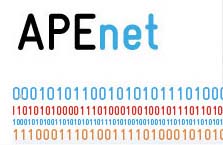
The APEnet project is a best practice network project supported by the European Commission in the eContentplus programme, in which currently the National Archives of 17 European countries plus the Europeana Foundation are building the Archives Portal Europe. In March 2011 the pilot installation of this future Archives Portal Europe has been launched at www.archivesportaleurope.eu giving access to more than eight million descriptions of archival units provided by about 50 different institutions from all over Europe and linking to more than 25 million digital archival objects on the content providers websites.
The portal‘s presentations and search facilities are based on a three-layers-concept of interrelated EAD (Encoded Archival Description) files:
- illustrating the archival landscape within the participating countries, including descriptions of the contributing institutions encoded in EAG (Encoded Archival Guide);
- describing all the fonds and collections kept by one archival institution in a general overview in the form of a holdings guide;
- providing descriptions of the archives in detail, each finding aid referring to a single fonds or collection or to a subgroup of it and giving access to the digitised documents--if any--via links to the content providers' websites.
In order to present this information from different archival institutions in the Archives Portal Europe as consistent as possible, the APEnet project has defined an European target profile and schema, the APEnet EAD, and provides tools to its partners enabling them to convert their local data formats into APEnet EAD and to validate the converted files against it, either in the central back-end of the Archives Portal Europe pilot, the dashboard, or via a stand-alone version. Furthermore, the tools offer the possibility to build an archival landscape encoded in EAD (only accessible online with prior registration), to create a holdings guide in EAD or an EAG document to describe one’s institution. More information on the stand-alone version of the tool as on the use of archival standards within the APEnet project can be found at the project website (section “About APEnet”).
Explore the APEnet project at http://www.apenet.eu/.
New Finding Aid System, Brigham Young University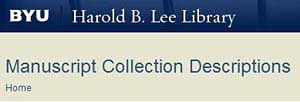
The Brigham Young University finding aid system has two main goals: to leverage archival inheritance and to present information to researchers in an intuitive way without losing archival context. User testing of the BYU system suggests that researchers are able to quickly understand the interface and achieve their research goals. One of the more innovative features of the BYU system is that it reduces the importance of management information in the finding aid. While researchers can still locate this type of information on one of the three tabs in our displays, it is intentionally deprecated.
Another important feature of the system is that it eliminates the difficulty that researchers often experience with hierarchical finding aids by providing researchers with single-level displays that are self-contained (that is they contain all of the information a researcher needs to determine whether they need to examine the materials). The system preserves the context of the materials by providing a contextual navigation pane in an unobtrusive manner.
The BYU system is also designed to facilitate the reuse of finding aid metadata. The single-level, inheritance-driven design provides significant opportunities for reusing the metadata contained in the finding aid. The components of the finding aids can be harvested using the Open Archives Initiative Protocol for Metadata Harvesting (OAI-PMH), with the ability to limit result sets to the varying levels of description. The system currently provides Dublin Core output, though we hope to add support for native EAD as well.
The BYU finding aids system reimagines how descriptive data can be presented to our users and how it can be repurposed by archivists. It points archivists in a new direction that will enable all of us to begin to leverage the possibilities of the digital world.
Explore the BYU finding aids system at http://findingaid.lib.byu.edu/.
Church History Library EAD tool, The Church of Jesus Christ of Latter-day Saints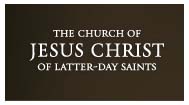
This new tool is a repository of archival finding aids created according to EAD and DACS standards. Each finding aid is created using database forms for each of the non-dsc sections. The dsc components are each created using forms for each logical level and are arranged (and may be rearranged) using a WYSIWYG creation tool that allows drag-and-drop (as permitted by business rules). The finding aid may be created incrementally over several sessions and then, after completion and approval, published. Finding aids marked published will then be available on the Web for discovery and browsing. Discovery will be through Primo.
The browse view, which is also used by the finding aid creators and editors, is designed to improve on a traditional finding aid page view. We borrowed the idea of play lists for navigation and display. We display columns showing multiple levels of content with clear visual cues about relationships, paths, and logical levels. Selecting a component may open a new column with sub-components and will always include any component-level data.
We are developing other services that may be selected for components, including a means to place a digitization request, or, if already digitized, a link to the digitized content. Contact: Max Evans at EvansMaxJ@ldschurch.org.
For more information, including updates on public release, see http://archivesmax.blogspot.com/2011/07/new-ead-tool.html.

JFK Digital Archives, the John F. Kennedy Presidential Library and Museum
The Digital Archives provides access to a growing collection of searchable digitized historical documents, images and materials. Archivists at the JFK Library are working to digitize and make available to the public all of our archival and museum holdings, beginning with the papers of President John F. Kennedy and his administration.
The vast majority of our holdings remain undigitized. Access to all of the Library's holdings, whether digitized or not, is provided through a single search interface which allows you to browse all of our holdings using our faceted navigation system and/or a traditional keyword search. Finding aids to specific collections can be found here, with links to digitized content where available.
Explore the JFK Digital Archives at http://www.jfklibrary.org/Research/Search-the-Digital-Archives.aspx.
Linked Open Copac and Archives Hub (LOCAH)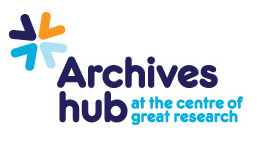
The LOCAH project is working to put archival and bibliographic data at the heart of the Linked Data Web, enabling new links to be made between diverse content sources and enabling the free and flexible exploration of data so that researchers can make new connections between subjects, people, organizations and places to reveal more about our history and society.
We have output a sample of the Archives Hub EAD descriptions as Linked Data. We developed a data model for our EAD descriptions and from this we developed a stylesheet to output RDF XML. This can be converted into other RDF formats.
Explore the LOCAH project at http://data.archiveshub.ac.uk.
Steady, North Carolina State University Libraries
Steady is an EAD web service tool from North Carolina State University Libraries, Digital Library Initiatives & Special Collections Research Center. Sometimes your donors have spreadsheets which list the contents of their collections. Or you may have legacy container lists in spreadsheets. Rather than retype all of these into a tool like Archivists Toolkit or an XML editor, wouldn’t it be nice to automatically generate a stub EAD XML document from the spreadsheet?
Steady is a simple web service which allows you to upload CSV files which use specific headers and output EAD XML to get your collection guide started. Both the code for the Rails web service (https://github.com/jronallo/steady) and the underlying Ruby library (https://github.com/jronallo/stead) are open source.
Steady was developed in support of the Changing the Landscape project. An important output of this grant has been timing studies which will allow other institutions to estimate time and costs associated with processing architectural collections. They have found that it is easier to sort and rearrange their data as a spreadsheet than it is to do this work within other tools like Archivists' Toolkit. Also, subjects and names can be more quickly applied at the file level, and quality assurance has become more efficient. The Changing the Landscape project has exceeded processing goals in part because of the time saved in creating EAD XML.
Steady is now being used by libraries across the United States. We invite you to try out the free service. Contact: Jason Ronallo at jason_ronallo@ncsu.edu.
Explore Steady at http://steady.heroku.com/.
Social Networks and Archival Context Project (SNAC)![]()
Leveraging the new standard Encoded Archival Context-Corporate Bodies, Persons, and Families (EAC-CPF), the SNAC Project is "unlocking" descriptions of creators from the descriptions of records (represented in the form of existing EAD finding aids), and will normalize, enhance, and link the name records together in exciting new ways. This research and demonstration project intends to serve as a foundation for providing integrated access to both the records and the socio-historical context in which the records were created. It is also developing an integrated portal to the name records, linked to resource descriptions in archives, libraries and museums, online biographical and historical databases, and other diverse resources. The name records are additionally linked to one another, to make explicit the social networks between the named entities. The project will thereby demonstrate a mechanism for providing unprecedented access to and historical context for a broad array of humanities materials.
SNAC is a collaboration between the Institute for Advanced Technology in the Humanities at the University of Virginia, the University of California at Berkeley School of Information, and the California Digital Library. it is funded by the National Endowment for the Humanities.
Explore the SNAC project at http://socialarchive.iath.virginia.edu/.
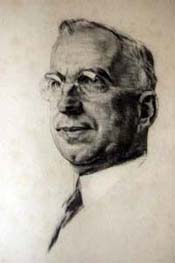
George S. Messersmith Papers, University of Delaware Library
Supported by a grant from the National Historical Publications and Records Commission (NHPRC), the University of Delaware Library has digitized the George S. Messersmith papers for online access. Researchers, who previously relied on discovery in the collection through use of a 700+ page typescript calendar, may now use an online finding aid to learn about the collection. The NHPRC grant allowed for "repurposing" the exhaustive descriptive data for this significant collection, migrating item-level document summaries from the legacy calendar into EAD-XML, an international standard for archival description and online access. The finding aid descriptions are linked to digitized documents stored in the Library's Institutional Repository, DSpace, where readers may browse the collection by various fields or use advanced searches to query full text of the PDF documents. Optical character recognition of the digitized documents maximizes searchability of the collection in D-Space. A Berkeley XML database on the Library's server supports browsing, searching, and delivery of the collection.
Explore the Messersmith papers at http://www.lib.udel.edu/ud/spec/findaids/messersmith/.
DSpace Finding Aid Interface, Wake Forest University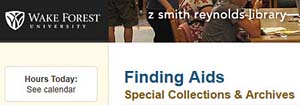
The Z. Smith Reynolds Library at Wake Forest University has transformed its finding aid collection within the university's DSpace repository, exploring an innovative alternative to locally developed, custom finding aid systems. With DSpace’s Manakin (XMLUI) interface, the library leveraged the strengths of EAD--structured data, hierarchical relationships--within an extensible interface development platform. Throughout the process of updating the finding aid interface, the ZSR Library questioned its operative notion of the traditional linear finding aid.
In crafting the layout, the library repositioned narrative and contextual elements and prioritized the descriptive over the administrative. To assist users interested in the contents of the collection itself and in response to usability studies, key changes include full-text search, emphasized abstract, collapsible collection inventory, and name index.
The library loosened the constraints of the normative stylesheet transformation by using an XML theme and treating EAD as the digital object in DSpace. In this way, a finished interface can be achieved in a single step: an EAD import into a DSpace collection. These critical qualities--extensibility and simplicity--enabled library staff to shorten the path to finding aid access.
Explore the WFU finding aids at http://zsr.wfu.edu/findingaids.
Home | Annual Reports | Standing Rules | Description Expo | Descriptive Notes | Minutes | Reports & Presentations | Section Leadership